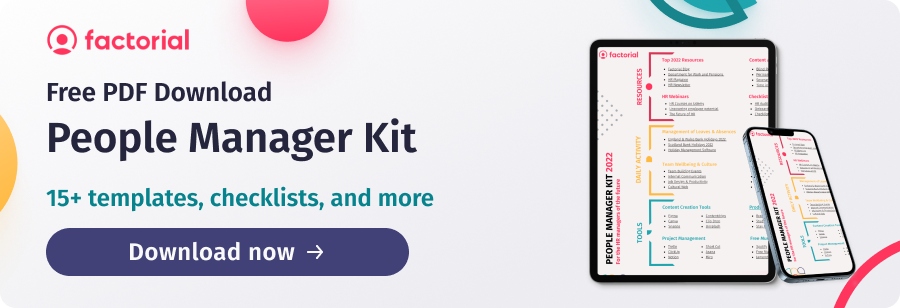Total Quality Management (known as TQM) is an approach to sustainable and long-term business success that focuses on customer satisfaction.
For TQM to be implemented successfully, all members of an organisation at all levels must be willing to participate in improving the processes, services and the culture in which they work.
In this article, we’ll guide you through the key principles of TQM and how to implement it in your organisation.
Table of Contents
- What is Total Quality Management?
- Why is TQM Important?
- Total Quality Management Principles
- Total Quality Management Examples
- Disadvantages of Total Quality Management
- How to Implement Total Quality Management
- Get Started With Factorial
What Is Total Quality Management?
TQM is a management philosophy which seeks to integrate all functions within an organisation – such as marketing, finance and customer service – so that the main focus becomes meeting customer needs whilst hitting organisational objectives and targets.
It is a continual process and involves detecting and reducing (or ideally eliminating) any problem areas in order to improve the customer experience.
TQM aims to hold all parties involved in every organisational process accountable for the overall quality of the final product and/or service.
Advocates of TQM view an organisation as a collection of different processes which ultimately all contribute equally to the bottom line. Organisations must strive to continuously improve these processes by incorporating the knowledge and experiences of workers.
This concept was originally applied to manufacturing operations but is now becoming recognised as an incredibly useful management tool in many different industries. Various industries and sectors have developed their own versions and evolutions of TQM but these foundations always remain the same:
- All employees and senior management must be 100% committed.
- All customer requirements must be met.
- Processes are key.
- Development of new products or services are streamlined.
- Organisations should have dedicated “Improvement Teams”.
- Reducing costs is integral.
- Systems and processes are implemented to facilitate improvement.
- Line managers must take ownership.
- Employees at every level should be involved and well-informed.
- Everyone’s achievements are recognised and celebrated.
- TQM should be specifically incorporated into strategic planning and decision making.
These foundations show the importance of getting buy-in and commitment from every team within an organisation. This especially applies to upper management who will be making overarching, strategic decisions.

Why Is TQM Important?
Total Quality Management leads to better services and products which are manufactured, distributed and provided at more efficient levels and at lower costs.
The increased efficiency also contributes to reducing waste and saving time, which results in reduced costs that customers can benefit from.
Companies that are able to successfully implement TQM are reducing the chances of any variation in their products and services, which leads to a consistency that customers truly value. Happy and satisfied customers become loyal, returning customers, which in turn leads to a sustainable, long-term business.
TQM is also incredibly important for employee engagement and employee satisfaction. When employees are engaged in what they are doing, turnover is greatly reduced which saves money on training and mistakes due to inexperience of new staff.
Total Quality Management Principles
Over the past few decades, TQM has been developed by academics whilst naturally evolving as it’s being implemented by organisations. It is now widely agreed that implementation of a TQM system will generally follow eight key principles, outlined here along with the benefits of each one:
Customer Focus
At its core, TQM is focused on the customer. The ultimate measure of success when it comes to TQM is whether or not the customer is satisfied with your services or product.
This principle ensures that the spotlight is put back on to the people who are buying your product or service. Quality is subjective and it’s determined by the users of your product. A quality product will completely fulfil the needs of the customer whilst also potentially outperforming competitors or lasting longer than expected. In these cases customers will know that they have spent their money on a high value, high quality product.
If an organisation can fully understand what their customers’ wants or needs are, they will always have a better chance of making changes and improvements that provide real value. This could be through improving materials and having processes in place that meet and exceed their expectations.
To effectively do so, your organisation must:
-
- Conduct regular research to understand your customers’ needs and pain points.
- Align your objectives with customer needs.
- Regularly communicate with customers, get their feedback and ensure the result of that feedback is used to improve processes.
- Effectively manage customer relationships.
- Find the right balance to keep stakeholders and customers happy. This might include employers, suppliers and investors.
The main benefits of being customer-focused include a likely increase in revenue from repeat customers. A strong and loyal customer base is also much more likely to recommend your company’s products and services.
Committed Employees
TQM cannot work unless all employees are involved in the process at an early stage and at a high enough level to actually have an impact.
You can’t increase productivity, processes or sales without your team being completely committed. They need to understand the purpose of TQM and the goals that are being put in place.
It’s also crucial that employees are trained properly and given all of the resources that they need in order to complete tasks.
To boost employees commitment to TQM, employers should:
- Communicate clearly and acknowledge the contribution of each individual.
- Make it known that each team or individual must accept ownership.
- You should give everyone the opportunity and autonomy to solve any problems that arise.
- Encourage employees to evaluate themselves and their performance against personal goals and objectives that they have been set. They should then be able to make adjustments if necessary to improve their work.
- Acknowledge successes and optimised performance to build confidence in your employees and your stakeholders.
- Provide adequate training, and make sure available resources are being used efficiently.
- Encourage your team to identify new opportunities to learn and advance into other roles, thereby increasing their knowledge and experience.
- Create an environment within which employees are able to be open and honest about problems and how to solve them.
Employees who are committed to the TQM process generally have much higher retention rates and are much more motivated. They become more involved in working towards the customer focused goals of the organisation, and take more pride in their work.
Process Driven
Adhering to processes is a crucial part of TQM as they encourage consistency and efficiency. To make your organisation more process driven, try:
- Using TQM tools such as process flowcharts. This will help to define clear roles and responsibilities within teams.
- Create an action plan that is visible to everybody so they can easily see the specific activities that need to be completed in a certain timeframe.
- Analyse and measure current activities to see where bottlenecks in the process lie and how improvements can be made.
- Continue to evaluate the impact that these processes might be having, and don’t be afraid to change things if they aren’t working.
Processes can lead to faster development and product cycles. Being more consistent also makes outcomes more predictable so that planning ahead is easier and accurate.

Integrated Systems
With new processes to implement, it’s important that they are seamlessly integrated into existing ways of working.
With integrated systems, each team should have a complete understanding of the policies and standards that the business is implementing. This cohesive approach encourages the company to always be on the lookout for opportunities to improve, giving them a competitive edge.
To implement integrated systems, you should aim to:
- Promote a culture within the workplace that is focused on quality.
- Help employees understand how their roles fit in within the company.
- Make training available for all employees who want to explore opportunities for advancement.
This new focus will help your business achieve excellence and meet or exceed customer expectations.
Strategic And Systematic Approach
Processes should be organised strategically and consider both short-term and long-term goals.
Speaking about this principle, the International Organization for Standardization (ISO) said: “Identifying, understanding and managing interrelated processes as a system contributes to the organisation’s effectiveness and efficiency in achieving its objectives.”
When introducing multiple new processes, they need to be managed as a system of processes in order to improve efficiency.
This principle is implemented incrementally and continually. Processes should be looked at on a regular basis with the goal of understanding how they can be improved and upgraded. This continual improvement should also be a measurable objective for your team whilst innovations and improvements are recognised and rewarded.
This approach also makes it easier to identify bottlenecks and contributes to improved capabilities across the organisation as a whole.
Continuous Improvement
We’ve mentioned continuous improvement and monitoring a lot already. This is because effectively implementing the other Total Quality Management principles naturally helps your business to always be on the lookout for improvements.
Continuous development of products, services and processes is integral to any successful business. Finding ways to improve processes and adapt your products and services to match changing customer needs is vital. But one hundred percent efficiency won’t happen overnight.
The most important thing is recognising, acknowledging and encouraging innovation and improvements in processes across the organisation. You’ll see improved reaction times from your team as they recognise inefficiencies and bottlenecks much quicker, helping to improve broken processes.
Decisions Based On Facts
The best business decisions are often based on data. Gathering real-time information is crucial to understanding your customers and your market. Making informed decisions based on this leads to a more targeted strategy.
To implement a sound data strategy, you should:
- Analyse and check your current data and data sources to ensure that everything is reliable and accurate.
- Make all of the relevant data available to your team and any other stakeholders. They may spot something you don’t!
- Make decisions based on the facts that you learn from the data, whilst still trusting your intuition and experience.
You will quickly find that you are making more informed decisions and will have the ability to defend any decisions that you make. You will also be able to justify changing any past decisions based on new data.
Communications
The final principle is effective communication. We all know that this plays a vital role in organisations that run smoothly, both during regular operations and when the organisation is going through big changes.
Everybody in your organisation needs to be aware of all of your plans, strategies, and methods. These will need to be communicated clearly to your entire organisation. There is a greater risk of failure if your teams don’t know what’s happening.
In order to establish efficient communication, your organisation must:
- Create official lines of communication that all employees know will be used to post updates, policy changes and inform them of new processes.
- Involve employees in the decision making where possible.
- Make sure each department understands its role. The people within that department should also understand their individual responsibilities and how they fit in with the rest of the company.
Clear communication boosts productivity as employees have a better understanding of how they are contributing and making a difference. They will also become more motivated if they are part of the decision making process. Having an open dialogue between teams also makes for easier coordination and cooperation.
Total Quality Management Examples
Being able to deliver Total Quality Management requires a tried and trusted methodology. There are several ways to manage quality and these have been developed over the years by different organisations. A few examples are outlined below.
Lean Manufacturing
This method of lean projection originated in Japan. More specifically, at the car manufacturer Toyota. The main focus is eliminating “muda”, or waste, in order to maintain or improve quality whilst adding value.
Six Sigma
Six Sigma is a quality management methodology focused on current processes, products or services, rather than introducing new ones. The idea is that by finding and removing any inefficiencies and defects in your current systems, you can streamline processes and improve quality with minimal effort.
ISO 9000
ISO 9000 is arguably the world’s best known quality management standard and is useful for companies of any size. There is a set of five international standards focused on quality management and quality assurance.
Disadvantages of Total Quality Management
One of the main drawbacks of TQM is the need for company wide commitment and buy-in from managers at every level. If just one team is not fully on board, it can cause a ripple throughout the organisation which will inhibit the TQM work being done. This will potentially undermine the success of TQM in the eyes of key decision makers.
Partial efforts are also destined to fail. You cannot be halfway in when it comes to implementing a TQM program.
A lot of companies often focus on the more tangible aspects of TQM, such as training and data collection as they can show that something has been done. But unless these are followed up on and integrated into the organisation as whole, they are unlikely to have any real impact.
How To Implement Total Quality Management
According to Project Manager, TQM requires complete commitment from upper management, which should include a commitment to learning about the methodology and best practices of TQM.
The easiest method of implementing TQM is known as PDCA. This stands for Planning, Doing, Checking, Adjusting.
Planning
Planning includes understanding the problem or opportunity as it relates to TQM. Collecting all data and simply brainstorming ideas will help you come up with an initial strategy about how to implement TQM.
Do
Start small, especially if you think there will be pushback or a lack of buy-in from other teams. Test your solutions by building a pilot program to see if you can achieve the quality improvements that you expected. Documenting this entire pilot process will make selling these processes easier.
Check
Analyse your data and the results of the pilot and compare them to what you expected to achieve. If you think you’ve met the criteria you set for yourself, then you can move on to the next step. If you’ve fallen short, don’t give up! Return to the planning stage with the valuable lessons that you’ve learnt.
Adjust
Once you’ve tested and are satisfied with your results, you can implement it at a large scale. This process has no beginning or end, and you may find yourself often going back to the planning stage and testing new ideas. Each success will become a new baseline which you can use to do further tests and make improvements.
You’ll need active participation from your stakeholders and those in key management positions. You can do this by creating a TQM steering committee and holding regular meetings to make sure everyone is on the same page and working together to improve quality.
You’ll also likely need smaller, cross-functional teams that can be responsible for making more immediate adjustments when issues arise. There are also standing cross-functional teams that have similar responsibilities but for long-term objectives.
Get Started with Factorial
Factorial’s all-in-one software converts clunky, manual processes into streamlined and effective ones, giving your team more time to implement TQM ideas and plans.
By replacing excel spreadsheets and endless paperwork with a digital solution, you will remove the common roadblocks that HR come up against. Your HR team will be equipped with the tools they need to learn and adapt to new processes.
Our HR software collates all of the processes related to time management, talent management, legal and finance in one place. This frees up valuable time that HR teams usually spend on administrative tasks, allowing them to focus on strategic decisions and improving company management.





